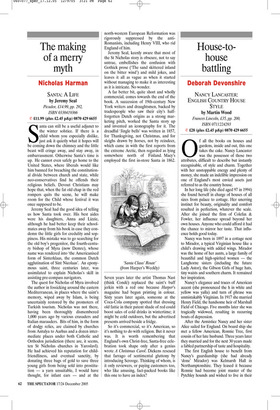The making of a merry myth
Nicholas Harman
SANTA: A LIFE by Jeremy Seal Picador, £14.99, pp. 292, ISBN 0330419366 ✆ £11.99 (plus £2.45 p&p) 0870 429 6655 Santa can still be a useful adjunct to the winter solstice. If there is a child whom you especially dislike, just ask it quietly what it hopes will be coming down the chimney and the little beast will cringe away, and stay away, in embarrassment. Otherwise Santa’s time is up. He cannot even safely go home to the United States, where liberals would like him banned for breaching the constitutional divide between church and state, while neo-conservatives find he offends their religious beliefs. Devout Christians may hope that, when the fat old chap in the red rompers quits the scene, he will make room for the Child whose festival it was once supposed to be.
Jeremy Seal had the good idea of telling us how Santa took over. His best aides were his daughters, Anna and Lizzie, although he had better keep their schoolmates away from his book in case they condemn the little girls for credulity and soppiness. His mistake was to go searching for the old boy’s progenitor, the fourth-century bishop of Myra (now Demre), whose name was rendered into ‘the Americanised form of Sinterklaas, the common Dutch agglutination of Sint Nicolaas’. An eponymous saint, three centuries later, was assimilated to explain Nicholas’s skill in assisting pre-compass navigators.
The quest for Nicholas of Myra involved the author in fossicking around the eastern Mediterranean, in places where the saint’s memory, wiped away by Islam, is being uncertainly restored by the promoters of Turkish tourism. Nicholas was not there, having been thoroughly dismembered 1,000 years ago by various crusaders and Italian marauders. Bits of him, in the form of dodgy relics, are claimed by churches from Antalya to Aarhus and a dozen intermediate places under both Catholic and Orthodox jurisdiction (there are, it seems, ten St Nicholas churches in Yaroslavl). He had achieved his reputation for childfriendliness, and eventual sanctity, by donating three bags of gold to save three young girls from being sold into prostitution — a yarn unsuitable, I would have thought, for infant ears — and at the north-western European Reformation was rigorously suppressed by the antiRomanists, including Henry VIII, who rid England of him.
Jeremy Seal, keenly aware that most of the St Nicholas story is obscure, not to say untrue, embellishes the confusion with Gothick prose (‘The sand skittered inland on the bitter wind’) and mild jokes, and leaves it all as vague as when it started without managing to make it as interesting as it is intricate. No wonder.
A far better bit, quite short and wholly commercial, comes towards the end of the book. A succession of 19th-century New York writers and draughtsmen, backed by tradespeople who saw their city’s halfforgotten Dutch origins as a strong marketing pitch, worked the Santa story up and invented an iconography for it. The dreadful ‘Jingle bells’ was written in 1857, for Thanksgiving, not Christmas, and for sleighs drawn by horses, not by reindeer, which came in with the first reports from the extreme Arctic, then regarded as lying somewhere north of Finland. Macy’s employed the first in-store Santa in 1862.
Seven years later the artist Thomas Nast (think Condé) replaced the saint’s buff jerkin with a red one because Harper’s magazine had begun printing in colour. Sixty years later again, someone at the Coca-Cola company spotted that dressing old fattie in their patent shade of red could boost sales of cold drinks in wintertime; it might be cold outdoors, but the advertised presents arrived beside a fridge.
So it’s commercial, so it’s American, so it’s nothing to do with religion. But it never was. It is worth remembering that England’s own Christ-free, Santa-free celebration took shape only after a genius wrote A Christmas Carol. Dickens rescued that farrago of sentimental gluttony by introducing Scrooge. Thinking of whom, is it only reviewers, or paying customers too, who like amusing, fact-packed books like this one to have an index?


















































































 Previous page
Previous page